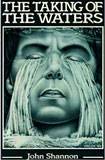 PALOS
VERDES BLUE
PALOS
VERDES BLUE
by John Shannon
Pegasus (USA)
$25.00 ISBN9781605980379
Palos
Verdes Blue is John Shannon's eleventh Jack Liffey novel.
Liffey is a 'child-finder' in Los Angeles, living a
somewhat dysfunctional life
with his Latina cop
girlfriend, and dealing with his
ex-wife and his rebellious teenage daughter. Jack once worked in the
aerospace
industry, but lost his job in the inevitable cutbacks, and, we intuit,
his
suburban world collapsed as a result. Now his ex has a friend whose
daughter
has gone missing, and she wants Jack to help. What he discovers his the
girl,
known as Blue, was a do-gooder, trying to save butterflies (the title
refers to
a butterfly) and help Mexican workers, illegal immigrants, living in
shanties hidden
on hillsides.
The concerns of the novel are mostly about community. Blue may have
been caught
in the turf war between the Bayboys, rich kids who surf the best beach
in Palos
Verdes, and the illegals; there are Aryan brotherhood type gangs
involved too.
As he investigates, Jack becomes involved with a precocious Mexican
teenager,
on the run from his home, who actually wants to surf, and his daughter,
who
seems to use an urge to help his investigations to distract her from
her own
problems, similarly befriends one of the Aryan surfers, who's
discovered he's
HIV positive. The story is richly layered, and the search for the
missing girl
is really just a catalyst for Shannon's careful
examination of the layers of
class-distinction that permeate his part of California. Shannon, like
Liffey, comes from San Pedro, and that
town's working class roots are in the background of this story, and a
more
important part of some of his other Liffey novels.

None of which have been published here,
although they're published by Pegasus, part of Norton, in the States. Shannon has also
written three 'mainstream'
novels, two in the 1970s, and Taking Of
The Waters (1994), published by a small press, which was a
generation saga
of a left-wing family. I'd be very interested in reading it, in light
of the
concerns noted above, and it's also interesting because the only one of
his
books to appear in the UK seems to be the spy thriller, Broken
Codes (1986) published by the estimable left-wing Pluto
Press.
Shannon lists
Raymond Chandler, Robert Stone,
and Jim Harrison as his influences; the Chandler is
obvious, and comes through strongest
in Palos Verdes Blue in the scenes where Liffey enters the gated
communities of
the rich and feels out of place. His descriptions of the hollowness of
the
material world echo Chandler's famous
views of LA. I'd imagine you'd
see more of Stone in his mainstream work; Courage
(1975) is apparently based on his own Peace Corps service in Malawi, and
Stone is particularly good on
Americans abroad. But Harrison
is a very strong influence; Harrison's
characters are men trying, with great
difficulty, to live up to masculine ideals (think of Legends
Of The Fall, his best book, and best-known via the movie),
but they, and the author's prose, as rarely as hard-boiled as they
ought to be.
My own comparison would be to James Crumley, which at first might sound
strange, since Liffey has
none of
the manic self-destructive energy of Crumley's characters, but again
there is
that overwhelming sense of a damaged hero, of someone trying to do the
right
thing, despite the difficulty. Liffey can resist temptation, like Chandler's
Marlowe, and unlike Crumley's heroes,
but there is a sense in which he moves through this narrative almost as
an
outsider, whereas Crumley's, and indeed Harrison's
protagonists are front and centre.
I say this for two reasons. First, Liffey shares the narrative with his
daughter, as she breaks new ground in her coming of age, and she is a
more
dynamic and sometimes more interesting character. In fact, Liffey
himself is at
his most interesting not when he is detecting, but when he is trying to
deal
with his aging and ailing part-coyote dog, Loco. Detectives don't have
to be
interesting in themselves; my all-time favourite, the Continental Op,
is as
non-descript as they come and even Marlowe's personality remains
backgrounded,
but if they are not then the other characters have to be arresting.
Which
brings me to the second reason I said Liffey is something of an
outsider in his
own book. Shannon also uses letters to reveal two of the characters;
Jaime the
Mexican is writing to his sister, not knowing if the letters will get
through,
and Twitch, the Bayboy being courted by the Aryans, writes to the
father who
has abandoned his mother and him. As a device, letters can be useful to
reveal
things that the narrative can't, the back stories of the two boys, one
forced
to leave, the other forced to stay alone. But the danger is that they
violate
the golden rule of showing, not telling, and after a while the letters,
particularly Jaime's, simply reinforce what we've already seen of the
story—we
don't need them to reinforce the idea that Liffey is a good guy for a
gabacho.
I get the feeling Shannon sometimes
needs to tell us too cu, and
is slightly too forward about it; there are a couple of footnotes in
the text,
where the author explains things I would rather have the characters or
the
narrative explain themselves. The letters are being translated by
Liffey's
daughter Maeve, which implies a continuation of the story; this seems
to be a
continuous series, but it wasn't difficult to join in progress.
Shannon writes
well, and his concerns for the
life of working class Americans are very well handled. When he finally
brings
the elements of this story together, he does create a tight bit of
suspense,
but the somewhat apocalyptic finale is a bit of an anti-climax. I
admire this
book for its rendering of its world, but I'll need to see more of
Liffey at
work before deciding whether the detective holds his series together.
Given the
quality of this book, that won't be difficult, though it would be
easier if a
British publisher took some notice!
|






